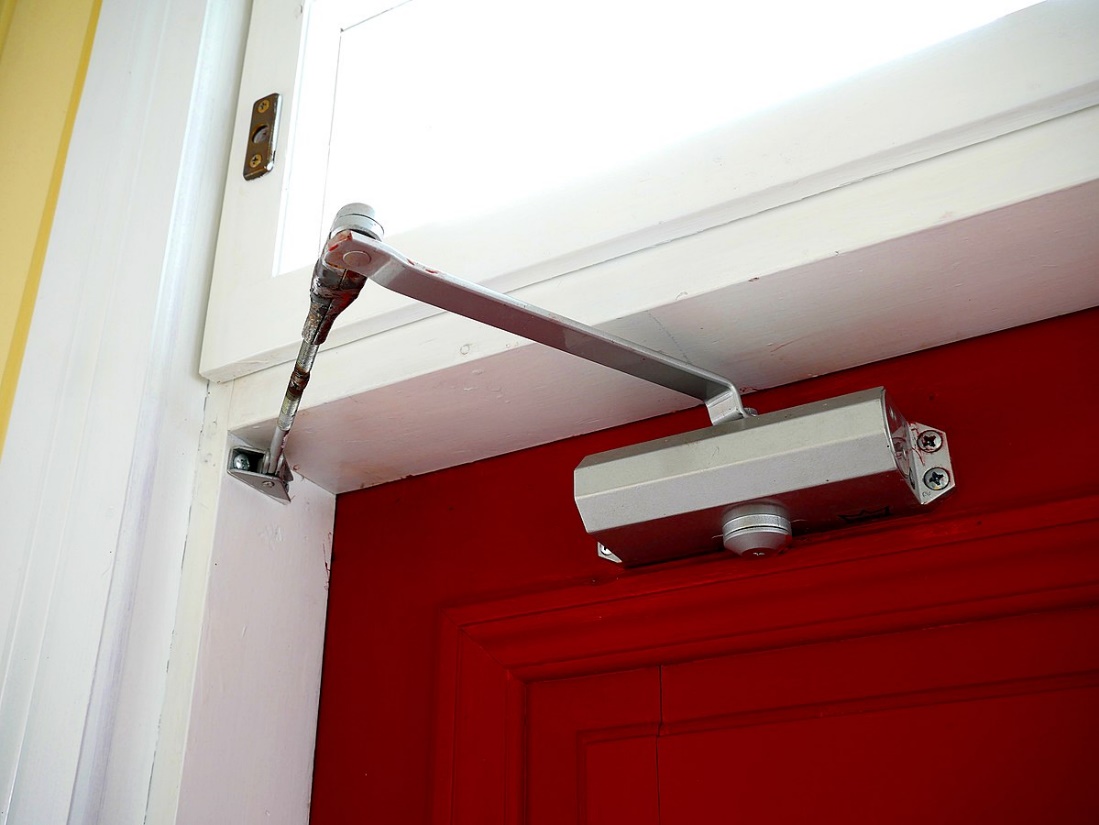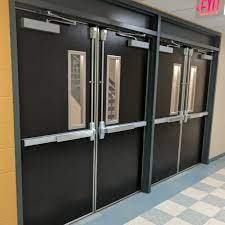Chapter E5 – Installs Exterior Door Hardware
Key Competencies
The NOA for Carpenter (2013) identifies the required competencies (skills) for the task of installing exterior door hardware. These are:
- Select and use tools and equipment such as levels, tape measures, hammers and cordless drills
- Select hardware such as locks, closers, and emergency devices according to jurisdictional requirements
- Position hardware using equipment such as templates and mortising jigs
- Secure hardware to door or window according to manufacturers’ specifications
- Adjust hardware to ensure smooth operation (NOA, p. 57).
Door Closers and Exit Hardware
Door closers are common in public buildings for sound control and fire control. Door closers operate pneumatically or hydraulically and have an adjustable spring mechanism for variations in speed and strength of closing action. Hydraulic closers are either surface mounted or concealed in the head frame or jamb.

Source: https://commons.wikimedia.org/wiki/File:Door_closer_20170214.jpg
Exit hardware (panic hardware) allows for easy exiting of a building and is commonly used in buildings with high occupancy such as schools and auditoriums. Exit devices can be installed on single doors, double egress and double doors. A door coordinator is installed on double doors to ensure that both doors close in proper sequence when opened at the same time. Dogging devices control access from the outside.

Types of Exit Hardware:
- Rim device
- Mortise-type
- Surface-Mounted vertical rods
- Concealed vertical rods
Review on Brightspace:
DOOR 300 – Doors and Hardware
Miscellaneous Hardware
Additional door hardware includes:
- Overhead door holders
- Flush bolts
- Surface bolts
- Kick, mop, and armour plates
Review Brightspace Instruction Sheet:
DOOR 300 Doors and Hardware (2015):
Review Questions
- According to their method of operation, the two types of closers are _____ and _____.
- Hydraulic closers can be _______ mounted or ______.
- True or False:
- Fluid is used to check the door in hydraulic door closers.
- Pneumatic closers are used on heavy type applications.
- Closers on doors along corridors are usually located on the room side of the door.
- Closers should be placed on the outside of exterior doors.
- According to section 3.4.6.16 (1) of the NBC, what are the requirements for door release hardware, excluding exceptions?
- How high can door release hardware be installed? (See NBC 3.4.6.16-6)
- How does a mop plate differ from a kick plate?
- What is the function of an armour plate?
- For commercial applications, what is the recommended distance from the floor to thea) Center of push plates ________ mm
b) Top of kick plate __________ mm
- Unless otherwise specified, how close to the bottom of the door should kick and mop plates be located?
Answers:
- Hydraulic and pneumatic
- Surface mounted or concealed
-
- True
- False
- True
- False
- The door is required to be readily opened from the inside; no more than one releasing operation; will open without requiring keys, special devices, or specialized knowledge of the door opening mechanism.
- No more than 1200 mm above the finished floor.
